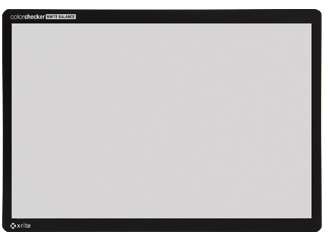Color Test Page for White Balancing Cameras
ColorChecker White Balance
The ColorChecker® White Balance target is spectrally neutral to deliver accurate white reproduction for both photo and video workflows. Use it to perform custom in-camera white balance to guarantee precise, uniform, neutral white - under any lighting condition.
Ideal for photographers and filmmakers .

The ColorChecker® White Balance target delivers accurate white reproduction. As lighting conditions change, your camera shifts the way it reproduces white; resulting in color shifts in your photos or video footage. Most white balance targets aren't neutral and could cause colors to shift under different lighting conditions. But the ColorChecker White Balance target is a scientifically engineered, absolute neutral white reference that prevents color shifts and provides precise, uniform surface that is spectrally neutral – in any lighting condition. That means you can be confident the image or footage you capture is as close to real life as possible.
ColorChecker White Balance also gives you a way to adjust your digital camera's color sensitivity to exactly match the ambient lighting conditions; in effect, change what the camera "sees." The perceived color of white changes based on ambient conditions—outdoor it is perceived to be cooler, indoor it is perceived to be warmer, and under fluorescent light, greener. Even in a controlled studio environment, this can be a problem. Whether on location or in your studio, establishing an accurate custom white balance before each photo session or video shoot ensures accurate colors from the start.
ColorChecker White Balance is a full-size version of the white balance target included in both ColorChecker Passport products. The actual color of the target is a light gray which provides the best white balance result.
Starting with an accurate white balance ensures the colors you capture are true and provides a point of reference for post-shoot editing. The ColorChecker White Balance target is a spectrally flat target that provides a neutral reference point across different lighting conditions that you encounter during a photo or video shoot. Since the target reflects light equally across the visible spectrum, creating an in-camera custom white balance can properly compensate for varying lighting.
You'll be able to:
- Eliminate color casts
- Improve the color preview on your camera's display so your histograms are more reliable
- Make post production color editing faster and easier by eliminating the need to neutralize each image individually
Setting a custom white balance for each lighting situation will make the previews on your camera's built in display more color correct, make your histograms more reliable, and speed up post production color editing. Raw shooters can capture anytime during the session to gain these benefits, while JPEG shooters should make it your first shot.
Why can't I use just any white object?
White balancing on a piece of paper or other gray element in the scene may seem like a simple workaround, but most objects are not actually neutral under all lighting conditions; and they're certainly not consistent. An inaccurate white balance will result in color casts and a lack of consistency between lighting conditions.
Achieve accurate white reproduction under any lighting condition.
Size: 8.25 x 11 in. (21.59 x 27.94 cm)
Number of Colors: 1
Description of Colors: ColorChecker white balance card is a full size version of the white reference square used in the standard 24-patch ColorChecker Classic
Shipping Weight: 0.5 lbs
| Downloads (0 Items) |  |
|---|
| Downloads (0 Items) | Version | Previous Version | Release Date |  |
|---|---|---|---|---|
| There are no downloads available at this time | ||||
ColorChecker White Balance
Part #: M50101 - Find a Dealer
Find a Local Dealer

Choose your Country to begin.
Find an e-retailer

Select your Country to begin.
Color Test Page for White Balancing Cameras
Source: https://xritephoto.com/colorchecker-white-balance
0 Response to "Color Test Page for White Balancing Cameras"
Post a Comment